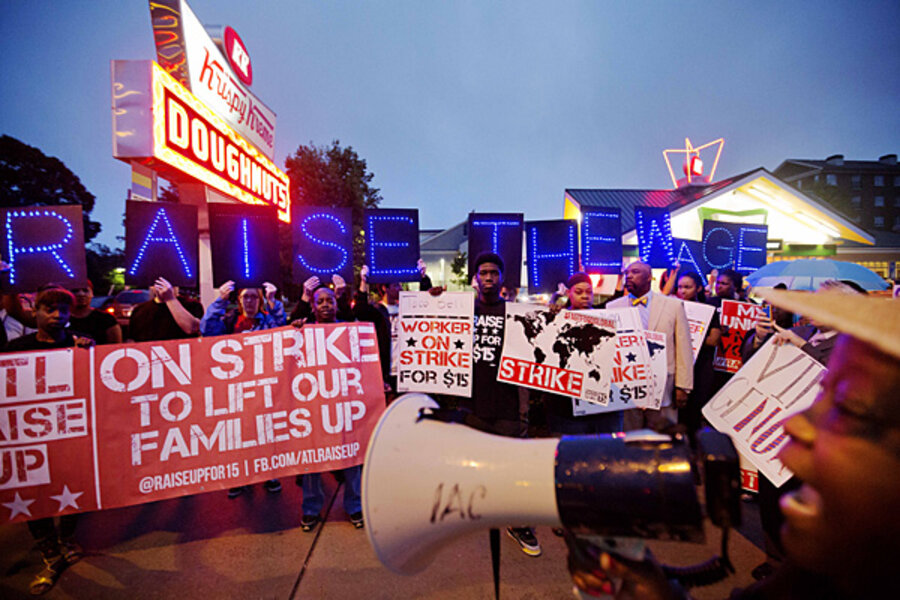Fast-food worker protests go global. Will it help?
Loading...
Over the past 18 months, fast-food workers and the outside firms that are helping them organize have staged several strikes across the US, demanding higher wages. But the fast-food industry these days is a global enterprise, so it only makes sense that the protest movement would eventually follow.
Today, another wave of strikes in US cities is being joined by several in cities in Europe, Asia, and South America, in an effort organized by the International Union of Food, Agricultural, Hotel, Restaurant, Catering, Tobacco and Allied Workers' Associations (IUF), a labor federation that represents 12 million workers in 126 countries, and the US-based Service Employees International Union. According to organizers, there will be demonstrations in 150 US cities, 30 cities in Japan, 20 in Britain, five in Brazil, and three in India.
“As it spreads, the movement is challenging fast-food companies’ outdated notion that their workers are teenagers looking for pocket change,” reads a release from BerlinRosen, the marketing firm helping to organize and publicize the protests. “Today’s workers are mothers and fathers struggling to raise children on wages that are too low. And they’re showing the industry that if it doesn’t raise pay, it will continue to be at the center of the national debate on what’s wrong with our economy.”
The movement’s stated goal has been to raise wages to $15 an hour for fast-food workers and give them the ability to freely unionize – demands that have gained little traction over the past year and a half despite taking several different forms. Last fall, advocates tried pushing the idea of low worker pay as a tax issue, pointing out that the gap between minimum wage and what is considered a “living wage” is often made up by various forms of taxpayer-funded public assistance. In March, workers in three states filed class-action lawsuits against McDonald’s and its franchisees, alleging that the company illegally docked pay by forcing employees to work off the clock and refusing to pay overtime.
It's unclear whether taking the protests global will be any more successful. However, the move accomplishes two things: For one, it brings the issue to parts of the world with a stronger labor union presence than the United States, and, in some cases, places where wage negotiations have actually yielded results. Second, it has the potential to hit fast-food companies in regions that account for big chunks of their revenue, like Asia, Latin America, and Europe.
Europe, not the US, is McDonald’s biggest revenue market, and fast-food workers in certain countries there have some bargaining power. Unions in Denmark formed a collective bargaining agreement with McDonald’s in 1989, giving workers the power to negotiate wages, according to the Huffington Post. McDonald’s employees there make the equivalent of about $21 per hour. And higher wages aren’t necessarily hurting McDonald’s’ business in those countries: In France, where the minimum wage is roughly $12 per hour, McDonald’s has 1,200 locations.
Fast-food workers have also successfully lobbied for raises in New Zealand and Australia – the latter’s Fair Work Commission worked out an agreement with McDonald’s last year for a worker wage increase, even though many of the chain’s employees were already making more than the $14.50 minimum wage.
Of course, those examples are the exception, not the rule, and things are still lousy for fast-food employees in less developed markets where workers also have no organizing power. In India, for example, the average McDonald’s worker makes about 50 cents an hour.
But taking the protest global is a logical step for those taking action against global companies, Lowell Turner, a professor of international labor relations at Cornell University, tells the New York Times. “It’s a global economy, so they’re saying, ‘Why not go overseas to make it into a global fight?’ ”






